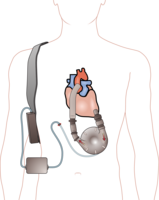
Photo from wikipedia
This new guideline from the AST IDCOP reviews intra‐abdominal infections (IAIs), which cause substantial morbidity and mortality among abdominal SOT recipients. Each transplant type carries unique risks for IAI, though… Click to show full abstract
This new guideline from the AST IDCOP reviews intra‐abdominal infections (IAIs), which cause substantial morbidity and mortality among abdominal SOT recipients. Each transplant type carries unique risks for IAI, though peritonitis occurs in all abdominal transplant recipients. Biliary infections, bilomas, and intra‐abdominal and intrahepatic abscesses are common after liver transplantation and are associated with the type of biliary anastomosis, the presence of vascular thrombosis or ischemia, and biliary leaks or strictures. IAIs after kidney transplantation include renal and perinephric abscesses and graft‐site candidiasis, which is uncommon but may require allograft nephrectomy. Among pancreas transplant recipients, duodenal anastomotic leaks can have catastrophic consequences, and polymicrobial abscesses can lead to graft loss and death. Intestinal transplant recipients are at the highest risk for sepsis, infection due to multidrug‐resistant organisms, and death from IAI, as the transplanted intestine is a contaminated, highly immunological, pathogen‐rich organ. Source control and antibiotics are the cornerstone of the management of IAIs. Empiric antimicrobial regimens should be tailored to local susceptibility patterns and pathogens with which the patient is known to be colonized, with subsequent optimization once the results of cultures are reported.
Journal Title: Clinical Transplantation
Year Published: 2019
Link to full text (if available)
Share on Social Media: Sign Up to like & get
recommendations!